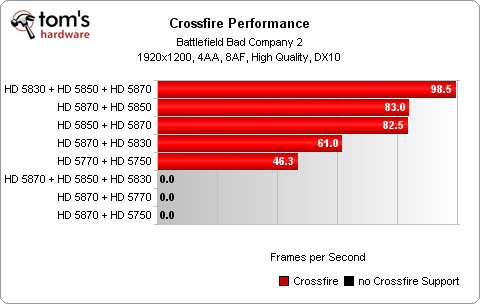Multi-GPU Setups: The Basics Of CrossFire And SLI
Motherboards with multiple PCIe slots are becoming the norm these days, and the trend is being fueled by multi-GPU configurations. Configuring Nvidia's SLI and AMD's CrossFire technologies is easy, but how much more performance can you expect from them?
Mixed-GPU Setups
If you want to run an SLI configuration, you can only use graphics cards with the same GPU model. Different graphics card manufacturers aren't a problem, but in a worst-case scenario, the hardware revisions or graphics card BIOSes may not match. The clock rates may be an important factor, as well. The first card (the one closest to the CPU) is usually the "master" in the configuration. If this card is overclocked, there's a risk that the second card will try to reach these speeds, too. If you suffer from frequent crashes or overheating, you should try adjusting the clock rates of the master card to match those of the second card (or even slower) and see if this makes the configuration more stable. Moreover, both cards have to have the same frame buffer, too.
AMD cards can be mixed, but you have to stay within the same series, as indicated in this chart. We tried pairing a Radeon HD 5800 card with a 5700 board, and of course it didn't work. Pairing a Radeon HD 5870 with an HD 5850 or an HD 5830 works fine, though. Whether this makes sense is debatable, given that a CrossFire configuration is at best only twice as fast as its weakest card. At least the flexibility is there, though. You can buy a cheap Radeon HD 5830 today, and, once prices fall, upgrade the computer with a Radeon HD 5850 or HD 5870.
The different combinations worked splendidly in our tests. With AMD graphics cards, you usually use the fastest one as the master card. The performance increase by doing this is very small, but it can be seen in all the benchmarks. Again, running a differently-clocked CrossFire combination might cause some issues due to higher clock rates of the master card. You need to either change clock rates or change the card sequence to fix this. We needed to do this with our three-way combination of the Radeon HD 5830, HD 5850, and HD 5870. The Radeon HD 5870 was rejected as the master card. Only when we used it as the third card in the configuration did it work properly. This arrangement doesn't really have an impact on performance, since all three cards will slow down to the speed of the Radeon HD 5830.
Get Tom's Hardware's best news and in-depth reviews, straight to your inbox.
Current page: Mixed-GPU Setups
Prev Page The Difference Between PCIe x8 And x16 Next Page CPU Scaling On AMD-
ramcrazy360 It's great to know there's so little difference between 8x and 16x preformance even with a 5850! I was worried about having a bandwidth issue with two 5770s, but it seems that won't be a problem.Reply -
Maziar Great review,however i wish you tested on resolutions like 2560x1600 and higher,because i think the main difference between 8x and 16x is in resolutions like that.Reply -
wildeast same as ramcrazy,Reply
i was going to get an i5 but that means a p55 mobo (x8+x8) not x58 (x16+x16), so i thought i should be getting x58 and i7 rig which is beyond my savings, thnx tom's am getting i5 + p55 now :) -
Tamz_msc Very nice article.It cleared a lot of confusion in my case.I would have liked to see scaling with increase in the number of CPU cores.Reply -
ruffopurititiwang Great article! Now we know what the deal is regarding multi-gpu and PCI-E lane speeds with mainstream setups.Reply
Now how about showing some love for top of the line setups? Can you apply the same tests to GTX 480/ATI 5870 Multi-gpu configuration + X58 mobo & 980X proc? -
rohitbaran On page 7, performance of Radeons in Alien vs Predator is not arranged properly with CPU speed.Reply -
lothdk rohitbaranOn page 7, performance of Radeons in Alien vs Predator is not arranged properly with CPU speed.Reply
All the tests are arranged by GPU performance not by CPU speed. -
TheStealthyOne I'll definitely be using this article as a reference for a dual 5850 machine I'm building :)Reply -
hixbot In every single TOMS article showing benches on CPU scaling, you use High resolutions with FULL AA and aniso! WHY?!Reply
I know thats how many would play the game, and it shows the performance that one would expect with different CPUs. It shows that we don't need to overclock or buy expensive CPUs, when the load (bottleneck) is on the GPU.
BUT if you would also show the CPU scaling in low resolutions and no AA/aniso, we could see how the CPUs might stack up. This is valuable for knowing how the CPUs perform in the future, when one might have upgraded the GPUs, and the bottleneck dissapears.
Yeah, yeah, this is not a CPU article... i know but still.. it shows CPU scaling, and every time I see CPU scaling demonstrated on toms, it's shown with a bottleneck on the GPU.
Humour us next time and include a bench or two with no GPU bottlneck (low res, eye candy). Just becaause that's not how we'd play the game, and just because the FPS would be insanely high, doesn't mean the numbers wouldn't be valuable. I complain about this in every article that includes CPU scaling.
It doesn't erk me that much here because this article isn't focused on CPUs. but for the love god, the next CPU article you do, when you test gaming, throw a bench or two in there with very low settings.





